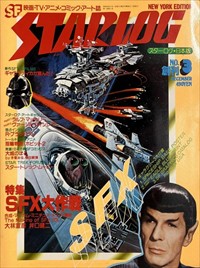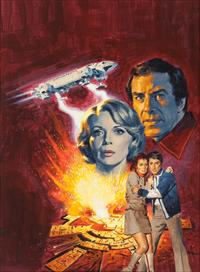Genre Magazines
Starlog
Starlog magazine was launched in August 1976. Although the initial focus was Star Trek, it also covered Space: 1999 in many early issues. The only other science fiction film and TV magazines of the time were Cinefantastique, which was much more analytical (see more), and the monster magazines aimed at teenagers, especially Famous Monsters of Filmland (see more). Initially quarterly, Starlog quickly moved to 8 issues per year, and by 1979 became monthly.
The magazine was originally intended to be a one-off Star Trek magazine, and turned into a regular magazine to avoid royalty fees to Paramount. Starlog concentrated on news and interviews. Columnist David Gerrold and occasional political editorials generated some heat in the letters page, but criticism quickly disappeared from the pages. There was a long running special effects series which was moderately technical (spun off into a series of Photo Guidebooks). Starlog was well placed to cover Star Wars and the boom in science fiction movies and television.
By the 1990s and 2000s, the design became increasingly messy and the content felt superficial compared to other titles that had appeared.
Starlog ran until 2009, the last issue being numbered 374. The entire run is available online at archive.org.
Early issues of Starlog had features on space science and space artists, and some science fiction book content, content that was spun off into sister publication Future Life (1978-1981). The main spin-off magazine was horror-focussed Fangoria from 1979.
Starlog also produced numerous books or limited run magazines, starting with their Spaceship photo guidebook in 1977, leading to numerous photo guidebook titles. Other spin-offs include a Trivia book, a Communications Handbook and poster magazine. They also produced books and magazines for specific films and TV series, one of the first being the Moonbase Alpha Technical Notebook in 1977.
By mid-1978 it was distributed widely in the UK (shortly after a British competitor, Starburst, had launched). A British edition was launched in 2000 and lasted 27 issues until 2002, with a larger, more modern format than the US edition, and UK news. There was an earlier UK magazine called Movie which lasted 2 issues in 1992, reprinting Starlog articles.

From 1978 there was a Japanese edition. This lasted 100 issues until 1987. Issue 3 (December 1978) reproduced the Geoffrey Mandel Eagle blueprint (coloured), while issue 13 (1980) had a pull-out calendar, with November and December devoted to Space: 1999. The Aliens Photo Guidebook was published in a Japanese edition.
With Space: 1999 still showing first run episodes in 1976 and 1977, it received good coverage in early issues. The first issue contained a 3 page article announcing the second series by editor David Houston. This was followed by a larger article, with episode guide, in issue 2, which featured a Space: 1999 cover. This second article coined the phrase MUF (Mysterious Unknown Force), which fans of the series embraced. All of the early issues in 1976-1977 (issues 1-7) mentioned Space: 1999 on the cover.
There was a regular Gerry Anderson column in the magazine from issue 15 to 41 in 1980. With the series now off-air, and with loads of new content to cover, Space: 1999 disappeared from the pages, apart from occasional interviews.
In 1981 Starlog ran a "fifth anniversary contest" with complicated rules; first and second prizes included Star Wars and Space: 1999 promotional books.

The cover art for Starlog 2, by Dick Kohfield (1931-2012). "He and his 14 year old son, Glenn, are fans of Space: 1999". In October 2014, the painting (16.5 x 12", gouache on board, titled "Space 1999- Astral Quest") sold for $3500.
Hirsch joined Starlog as an intern in 1977, aged 20. He quickly became an associate editor. He left in 1983, although continued as an occasional contributing writer, mainly about film music.
He was closely involved in the organisation of the first Space 1999 conventions in 1978, 1979 and 1982
Having travelled to the UK to interview Gerry in late 1977 for the Starlog column, he was involved in the development of the aborted movie project Five Star Five as well as early development of Terrahawks
He was a "creative consultant" to ITC's Super Space Theatre compilation movies, including the two 1999 titles, Journey Through The Black Sun (1982) and Cosmic Princess (1982). He was responsible for selecting the episodes and suggesting cuts and dialogue changes. A detailed account is in Gerry Anderson's Super Space Theater by Chris Drake (2019, Fanderson)
He would later write scripts for Gerry Anderson-based audio stories for Big Finish (Terrahawks 2, 2016 and Terrahawks 3, 2017)
Selected bibliography:
Space: 1999 copyright ITV Global Entertainment